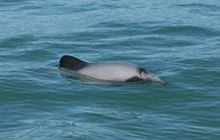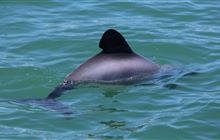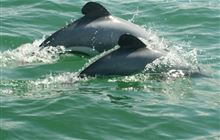Toxoplasmosis and Hector’s and Māui dolphin
Introduction
Toxoplasmosis is a parasitic disease which reproduces in cats and is a significant threat to dolphins.A significant threat to Hector’s and Māui dolphins
Toxoplasmosis is an infection caused by the Toxoplasma gondii parasite. The parasite is common and capable of infecting many animals, including humans. Up to one third of people worldwide carry T. gondii, although most never develop symptoms.
Toxoplasmosis is, however, a confirmed cause of death in Hector’s and Māui dolphins and is likely to be a significant human-caused threat to the dolphins’ populations. This is especially the case for the critically endangered Māui dolphin.
Toxoplasmosis is a cause of death in marine mammals elsewhere, including southern sea otters and Hawaiian monk seals, and is also known to cause behavioural changes, still births and reduced reproductive rates.
With only 54 Māui dolphins over the age of one left, according to our last population survey, the most immediate risk is to this subspecies.
How are dolphins exposed to the parasite?
Cats are the only animal in which the toxoplasma parasite can sexually reproduce. The parasite creates oocysts (eggs) in the guts of cats that are spread into the environment via cat faeces where they can survive for many months.
Rainwater and run-off transport the oocysts into streams, rivers and stormwater drains, as well as waste water when cat faeces or kitty litter have been flushed down the toilet. Hector’s and Māui dolphins can then become infected when they ingest contaminated water or prey (fish).
There is no vaccine available for cats or dolphins.
Unfortunately, toxoplasma oocysts cannot be treated by standard wastewater treatment methods, such as UV radiation.
Addressing this threat requires multiple approaches to reduce the amount of the parasite entering rivers, estuaries and flowing out to sea.
How you can help
To help prevent the parasite from reaching Hector’s and Māui dolphin:
- keep cats indoors
- dispose of cat faeces in the rubbish bin, not the toilet
- spay or neuter your cat
- do not abandon unwanted cats or feed feral cats
- support wetland conservation, which helps stop eggs reaching the ocean
- include green spaces in your garden or barkyard to help filter rainwater and reduce stormwater runoff.
Toxoplasmosis action plan
This plan addresses the threat of toxoplasmosis to Hector’s and Māui dolphins.
Toxoplasmosis funding – Budget 2022
As part of a significant spend on conservation in Budget 2022, the Government committed $4.88 million to a three-year work programme focussing on toxoplasmosis, and how it impacts Māui dolphins.
This funding started in the 2023/24 financial year, and will be spent on research to inform actions to reduce the risk to Māui dolphins from toxoplasmosis.
There’s a range of information on toxoplasmosis on this page, explaining the risk the parasite presents to these taonga marine mammals
Research under this Budget 2022 funding will:
- develop tools to detect and quantify oocysts
- recover dead dolphins for necropsy and disease screening
- understand the total economic burden of the T. gondii parasite to New Zealand
- identify hotspots for the parasite entering Māui dolphin habitat
- trial management methods to reduce the parasite getting into waterways.
The actions will include partnerships with iwi, and coordination with other agencies and stakeholders to provide research, trial solutions, and deliver management actions.
Our goal by 2035 is to reduce Toxoplasma loading to the marine environment so the number of dolphin deaths attributable to toxoplasmosis is near zero.
Factsheet
Download the information on this page with images in a factsheet (PDF, 903K)



